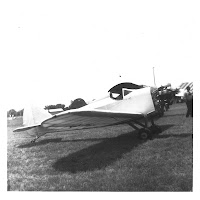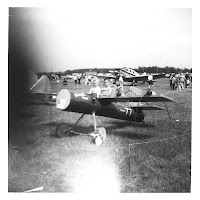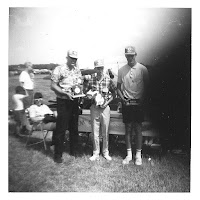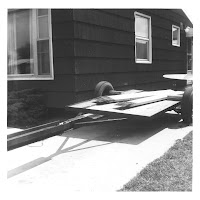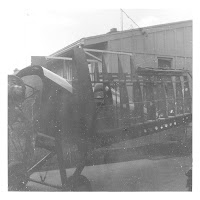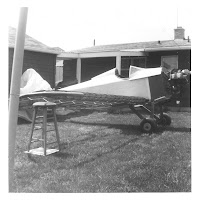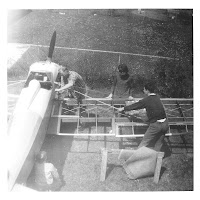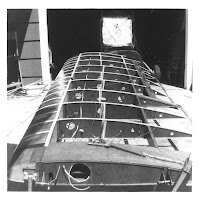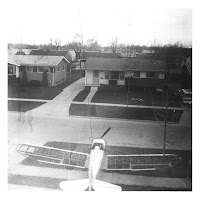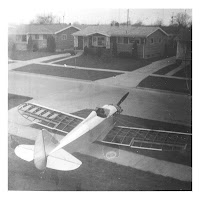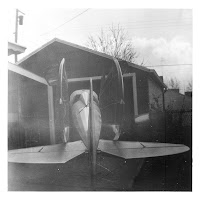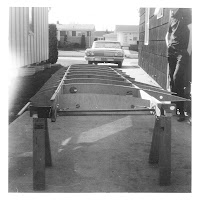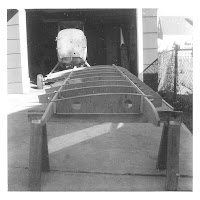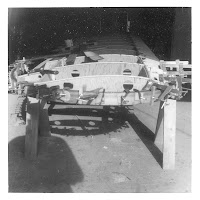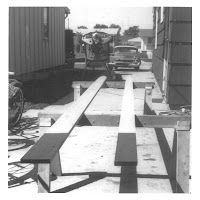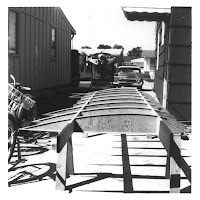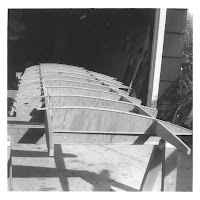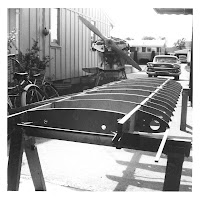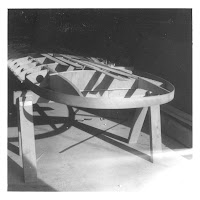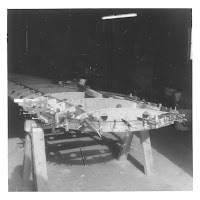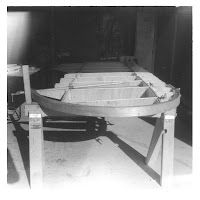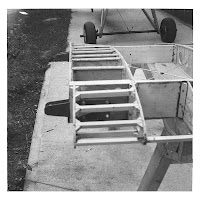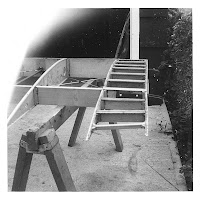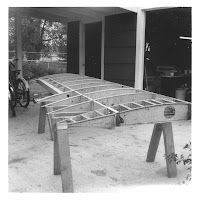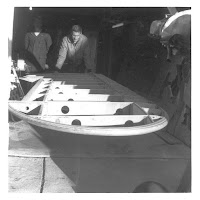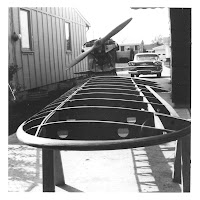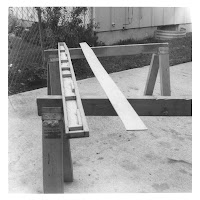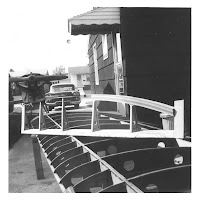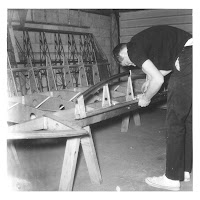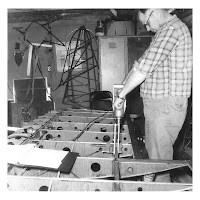Dennis: As with the fuselage and tail, the wings were covered with the blanket method, as opposed to a sewn envelope. The first coats of clear dope were sprayed on because the fabric was impregnated with dope. It's always nice to have a willing helper to flip the wings over, thanks Mom.
With the first coats of clear dope dry and the fabric tight the re-enforcing tapes were applied over the ribs and stitching done. In hind sight it seems silly to have a lifetime fabric installed with standard waxed rib stitch cord. I really like the hidden knots developed by Stits. The old style knots are a pain to sand around.
Surface tapes, inspection rings and drain grommets finished the easy work. Now it's time to wet sand the aluminum dope for a good finish. The white stripe on the fin is because we installed the gap fillers and then applied the fabric over them. It all pulled lose at the bottom rib on the fin. We cut it off and ran the fabric under the first rib, re-installed the aluminum pieces and taped over the joints. It all came out fine in the end but very annoying.
Sunday, January 8, 2012
Thursday, January 5, 2012
Lansing Fly-in - June 1966
Dennis: The plane is ready to go. The fly-in was held over a weekend at the Lansing, Michigan airport. At this point I had just graduated from high school and we had been working on the plane for 2 1/2 years. We were getting close to being done and very determined to have it flown before the Rockford fly-in the end of July.
There was a good crowd and we had fun showing off the plane. The only bad thing was the preacher and his wife who got picked as chairman left for Texas on Sunday with all the cash, what a mess.
This was made as a float for a parade. We lived in Flint so it was in a Flintstone Flyer motif. The kids setting on it are Dwayne Trovillion's kids.
Not only did we have fun, but won awards. Dad has the trophy for best wood built plane. I'm not sure what the award Dwayne has is for. Mine was for youngest pilot. That summer I worked for Jim Narrin who had started a flight training business at Bishop airport. Basically I answered the phone when he was at work of flying and did odd jobs in exchange for flight time. It was very kind of him and Barb to let me spend the summer hanging out at he airport. It was hard to get a real job until you turned 18 so it was good fun. I did some drafting work for the city schools, pocket money, while sitting in his office every day.
There was a good crowd and we had fun showing off the plane. The only bad thing was the preacher and his wife who got picked as chairman left for Texas on Sunday with all the cash, what a mess.
This was made as a float for a parade. We lived in Flint so it was in a Flintstone Flyer motif. The kids setting on it are Dwayne Trovillion's kids.
Not only did we have fun, but won awards. Dad has the trophy for best wood built plane. I'm not sure what the award Dwayne has is for. Mine was for youngest pilot. That summer I worked for Jim Narrin who had started a flight training business at Bishop airport. Basically I answered the phone when he was at work of flying and did odd jobs in exchange for flight time. It was very kind of him and Barb to let me spend the summer hanging out at he airport. It was hard to get a real job until you turned 18 so it was good fun. I did some drafting work for the city schools, pocket money, while sitting in his office every day.
Trailer For Towing Fly Baby - June 1966
Dennis: Along with being a detective, uncle Bruce worked part time making trailers. He took a small trailer and added a long tongue with a track for the tail wheel. It actually worked very well. The plane was towed from Flint, Mich. to Rockford, Ill. later in the summer for the EAA fly-in. The ramps are 2x10's with some steel plates bolted to the ends for an attachment to the trailer. The blocks bolted down by the wheels are the chocks for for the main wheels on the plane.
There are some eye-bolts near the wheel chocks for tying down the axle. The tail is tied down to the tongue with the wheel trapped in the channel. When the plane was towed to Rockford the Interstate was closed to trucks due to high cross winds. The cops let Dad drive right on through. I guess they thought a plane was safe in the wind. As it turned out it made it just fine. I think dad's nerves were shot. I don't think the idea of 2 1/2 years of work laying as toothpicks beside the road appealed to him.
At this point the wins have fabric but no dope. The plane is loaded for a 1 hour drive to Lansing for a regional fly-in.
There are some eye-bolts near the wheel chocks for tying down the axle. The tail is tied down to the tongue with the wheel trapped in the channel. When the plane was towed to Rockford the Interstate was closed to trucks due to high cross winds. The cops let Dad drive right on through. I guess they thought a plane was safe in the wind. As it turned out it made it just fine. I think dad's nerves were shot. I don't think the idea of 2 1/2 years of work laying as toothpicks beside the road appealed to him.
At this point the wins have fabric but no dope. The plane is loaded for a 1 hour drive to Lansing for a regional fly-in.
Labels:
General Info,
Trailer
Tuesday, January 3, 2012
Rigging Wings - Spring 1966
Dennis: At this point the wings are ready to rig. The folding mechanisms work as do the controls but the wings are not really attached to the fuselage. The holes in the fuselage for the wings to attach have not been drilled. Nor have the holes in the attach fittings on the wings. One hole in each pair of fittings was drilled. There is a fitting on the front and back of each spar, 8 fittings in total. Slots are made in the sides of the fuselage, while building it, to allow the fittings to slide into the fuselage and be pinned to the bulkheads.
The first step was to position the wings square to the fuselage center line and lifted to the correct dihedral. The board setting on the wing next to the fuselage is the gauge we used to check the dihedral angle. With the wings positioned the wing root was positioned to set the angle of incidence and the pin holes drilled through the bulkhead and the undrilled fitting.
With the wings attached the flying and landing wires were made to fit. You have to get them snug and the length such that you can still adjust all the wires as the final tension is set once all the wires are made. To save cable we looped the cable through the turnbuckle and nicopress sleeves at the fuselage then down to the fitting at the wing spar.
Once the fitting end was done then you could pull the cable snug with plenty of cable to hold on to while the nicopress is squeezed. Then the end of the cable is cut and none is wasted.
With the rigging complete the aluminum leading edge was nailed on and the wings were ready for covering.
Time to relax a little. This thing is really looking like an airplane.
The wing folding hinge pin and the pins for attaching the wings to the fuselage for flight.
Ready for fabric.
A chance to show the neighbors this thing will soon be flying.
The first step was to position the wings square to the fuselage center line and lifted to the correct dihedral. The board setting on the wing next to the fuselage is the gauge we used to check the dihedral angle. With the wings positioned the wing root was positioned to set the angle of incidence and the pin holes drilled through the bulkhead and the undrilled fitting.
With the wings attached the flying and landing wires were made to fit. You have to get them snug and the length such that you can still adjust all the wires as the final tension is set once all the wires are made. To save cable we looped the cable through the turnbuckle and nicopress sleeves at the fuselage then down to the fitting at the wing spar.
Once the fitting end was done then you could pull the cable snug with plenty of cable to hold on to while the nicopress is squeezed. Then the end of the cable is cut and none is wasted.
With the rigging complete the aluminum leading edge was nailed on and the wings were ready for covering.
Time to relax a little. This thing is really looking like an airplane.
The wing folding hinge pin and the pins for attaching the wings to the fuselage for flight.
Ready for fabric.
A chance to show the neighbors this thing will soon be flying.
Right Wing - Spring 1966
Dennis: The right hand wing is a mirror image of the left wing. Both were relatively easy and satisfying to build.
I think a person could use strips of different widths to reduce the shaping work on the wing tips. I'm not sure it would be worth the work of trying to keep all the pieces lined up. I'm sure you could save some wood if you could pull it off. Fortunately Redwood is relatively cheep and because of it's grain, relatively easy to carve to shape.
With this the basing structure of the plane is done. Now it's time to install and rig the wings.
I think a person could use strips of different widths to reduce the shaping work on the wing tips. I'm not sure it would be worth the work of trying to keep all the pieces lined up. I'm sure you could save some wood if you could pull it off. Fortunately Redwood is relatively cheep and because of it's grain, relatively easy to carve to shape.
With this the basing structure of the plane is done. Now it's time to install and rig the wings.
Sunday, January 1, 2012
Left Wing - Fall/Winter 1965
Dennis: As I recall the spars took several months to arrive. While we waited we built ribs. The plans suggest stacking the plywood and sawing several parts at once. It might work if you can get the blade tight enough and go slow enough. It doesn't take much flexing of the blade to make parts which are quite different from each other. I would rather cut out the ribs with a router and template. The other thing which was a bit of a pain was trying to nail on the cap strips to the plywood webs. The strips have a groove cut in them the full length to fit down over the web. When you nail through the strip it easily splits. I'd do it with some "0" shaped strips of plywood and wedges to clamp the strips tight to the webs.
Everything needs to be drawn out on the spars before you start assembly and all holes drilled. It quickly starts looking like a wing. It really is much like building a model.
The compression struts, drag and anti-drag wires need to be in and the wing trammeled before to much is done to hold everything square. For me the wings are always the most fun. These are great to build.
The wing tip bows are made from strips of redwood 1/8" thick and about 2" wide. The first strip gets glued and nailed in place then the others get glued and clamped to it just like building the tail surface trailing edges only bigger and heavier, much bigger. It also takes a lot of clamps. Everything needs to be staged and that first strip needs to be well attached.
We let the wing tip set until everything else was done on the structure. There is a lot of wood to remove and we wanted to be sure nothing came apart.
The support for the aileron push rod keeps the push rod from doing damage in the wing when the wings are folded. It's easier to instal before the wing walk is installed.
The wing walk is probably the most tedious part of the wing. It's just tight to get in and nail all the corner blocks
Aileron opening.
Shaping the wing tip bow is probably easiest done with a draw knife. Once the carving is done the tip needs to be sanded smooth. Rough carving will show through the fabric, I've seen some that were crudely carved..
So cool to have built a wing.
The aileron is basically built like the tail surfaces. The spar is a box beam and the ribs are plywood with 1/4" square sticks. The curved portion of the trailing edge is part of the wing tip bow. The straight portion of the trailing edge and on the wing is a piece of aluminum trailing edge.
I changed my mind. The most tedious task is varnishing all the wood, 2 coats. One thing for sure i would do differently is to use Epoxy Varnish. Spar Varnish can not be used where the dope will attack it through the fabric. Those areas need to be varnished. Moisture gets under the fabric and rot starts.
Once the varnish dries the ribs are stiffened by criss crossing twill tapes between the ribs.
The aileron is hinged with sections of piano hinge bolted on.
Drilling the holes for the brace wire fittings after the wing was done was way to hard. If I were doing it again I would pre-drill the holes in the blocks and then transfer the holes to the fittings.
Everything needs to be drawn out on the spars before you start assembly and all holes drilled. It quickly starts looking like a wing. It really is much like building a model.
The compression struts, drag and anti-drag wires need to be in and the wing trammeled before to much is done to hold everything square. For me the wings are always the most fun. These are great to build.
The wing tip bows are made from strips of redwood 1/8" thick and about 2" wide. The first strip gets glued and nailed in place then the others get glued and clamped to it just like building the tail surface trailing edges only bigger and heavier, much bigger. It also takes a lot of clamps. Everything needs to be staged and that first strip needs to be well attached.
We let the wing tip set until everything else was done on the structure. There is a lot of wood to remove and we wanted to be sure nothing came apart.
The support for the aileron push rod keeps the push rod from doing damage in the wing when the wings are folded. It's easier to instal before the wing walk is installed.
The wing walk is probably the most tedious part of the wing. It's just tight to get in and nail all the corner blocks
Aileron opening.
Shaping the wing tip bow is probably easiest done with a draw knife. Once the carving is done the tip needs to be sanded smooth. Rough carving will show through the fabric, I've seen some that were crudely carved..
So cool to have built a wing.
The aileron is basically built like the tail surfaces. The spar is a box beam and the ribs are plywood with 1/4" square sticks. The curved portion of the trailing edge is part of the wing tip bow. The straight portion of the trailing edge and on the wing is a piece of aluminum trailing edge.
I changed my mind. The most tedious task is varnishing all the wood, 2 coats. One thing for sure i would do differently is to use Epoxy Varnish. Spar Varnish can not be used where the dope will attack it through the fabric. Those areas need to be varnished. Moisture gets under the fabric and rot starts.
Once the varnish dries the ribs are stiffened by criss crossing twill tapes between the ribs.
The aileron is hinged with sections of piano hinge bolted on.
Drilling the holes for the brace wire fittings after the wing was done was way to hard. If I were doing it again I would pre-drill the holes in the blocks and then transfer the holes to the fittings.
Subscribe to:
Posts (Atom)







